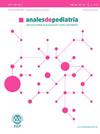Intoxicaciones por errores de dosificación de fármacos en España
IF 2.1
4区 医学
Q2 PEDIATRICS
引用次数: 0
Abstract
Introduction
Dosage errors are a common mechanism of poisoning in childhood. The aim of this study was to analyze the characteristics and management of poisoning secondary to dosage errors in pediatric emergency departments (EDs) in Spain.
Methodology
Study based on a prospective register of poisonings documented in 58 Spanish EDs participating in the Toxicology Surveillance Observatory of the Spanish Society of Paediatric Emergency Medicine (SEUP) between 2008 and 2023.
Results
The register documented 3429 episodes of exposure to toxic substances, of which 289 (8.4%) were medication dosing errors, with a vast majority occurring in the home setting. Seventy-eight (27.0%) occurred in children aged less than 1 year (amounting to 37.9% of poisonings in this age group and 85.0% of poisonings in infants aged less than 3 months). Overall, the most commonly involved medications were antipyretics/analgesics (35.6%, mainly paracetamol), with significant differences depending on patient age. Forty-nine of the patients (17.0%) were symptomatic, 118 (41.8%) underwent additional testing, 83 (28.7%) received treatment, and 115 (39.8%) were admitted to the ED observation unit or to hospital. All had favorable outcomes.
Conclusions
Medication dosing errors constitute an important mechanism of poisoning, especially in children aged less than 1 year, leading to a significant number of interventions in EDs. Preventive measures aimed at educating families to avoid these poisonings should be considered.

西班牙的药物错误剂量中毒
剂量错误是儿童中毒的常见机制。本研究的目的是分析西班牙儿科急诊科(EDs)剂量错误继发中毒的特点和处理。方法研究基于2008年至2023年间参加西班牙儿科急诊医学学会(SEUP)毒理学监测观测站的58名西班牙急诊科医生的前瞻性中毒记录。结果登记记录了3429例有毒物质暴露事件,其中289例(8.4%)为给药错误,绝大多数发生在家庭环境中。78例(27.0%)发生在1岁以下的儿童中(占该年龄组中毒的37.9%,占3个月以下婴儿中毒的85.0%)。总体而言,最常涉及的药物是退烧药/镇痛药(35.6%,主要是扑热息痛),根据患者年龄有显著差异。其中49例(17.0%)出现症状,118例(41.8%)接受了额外检查,83例(28.7%)接受了治疗,115例(39.8%)被送入急诊科观察或住院。所有的结果都很好。结论给药错误是中毒发生的重要机制,尤其在1岁以下儿童中,导致急诊科采取大量干预措施。应考虑采取旨在教育家庭避免这些中毒的预防措施。
本文章由计算机程序翻译,如有差异,请以英文原文为准。
求助全文
约1分钟内获得全文
求助全文
来源期刊

Anales de pediatria
医学-小儿科
CiteScore
2.10
自引率
4.80%
发文量
155
审稿时长
44 days
期刊介绍:
La Asociación Española de Pediatría tiene como uno de sus objetivos principales la difusión de información científica rigurosa y actualizada sobre las distintas áreas de la pediatría. Anales de Pediatría es el Órgano de Expresión Científica de la Asociación y constituye el vehículo a través del cual se comunican los asociados. Publica trabajos originales sobre investigación clínica en pediatría procedentes de España y países latinoamericanos, así como artículos de revisión elaborados por los mejores profesionales de cada especialidad, las comunicaciones del congreso anual y los libros de actas de la Asociación, y guías de actuación elaboradas por las diferentes Sociedades/Secciones Especializadas integradas en la Asociación Española de Pediatría.
 求助内容:
求助内容: 应助结果提醒方式:
应助结果提醒方式:


